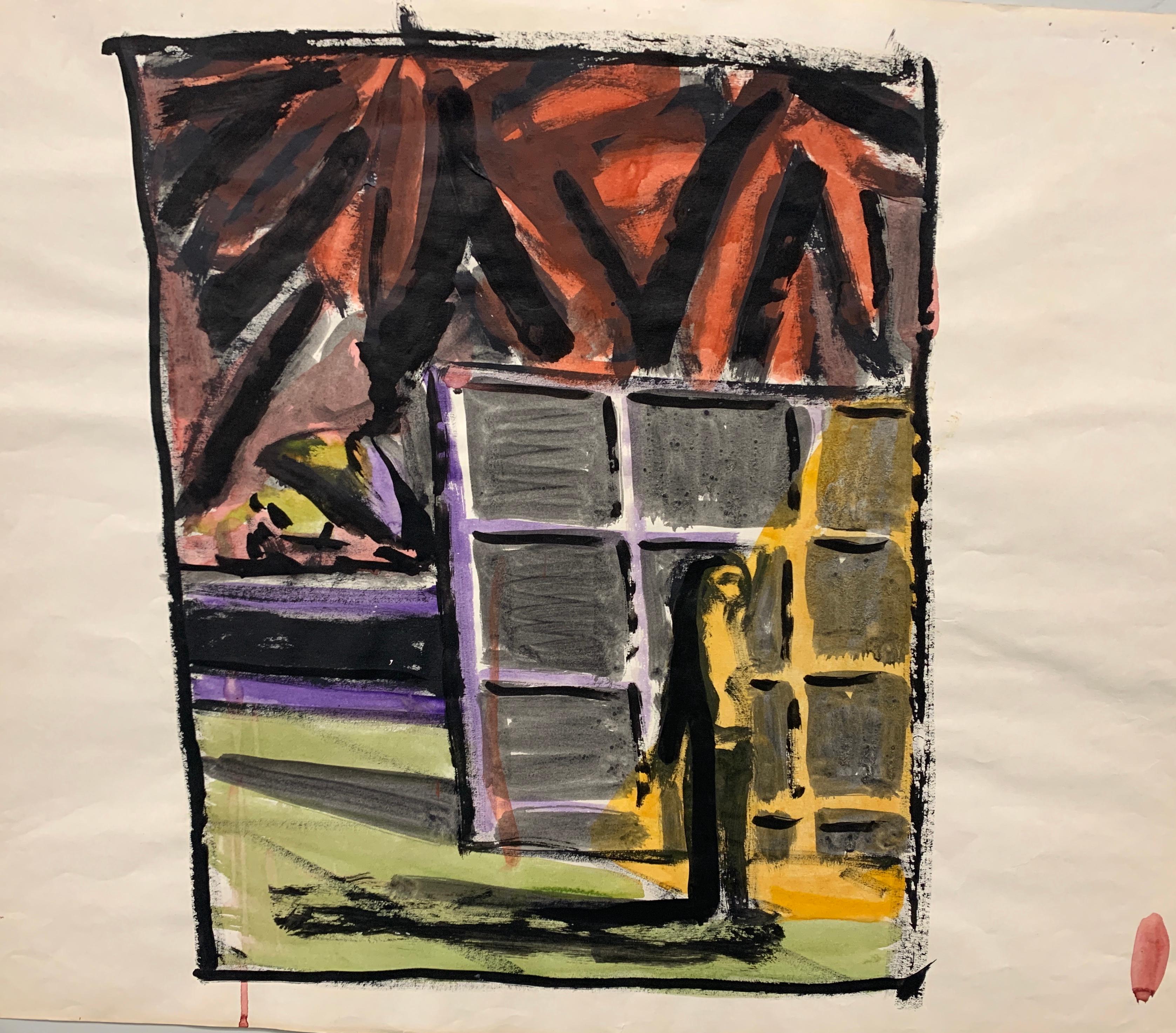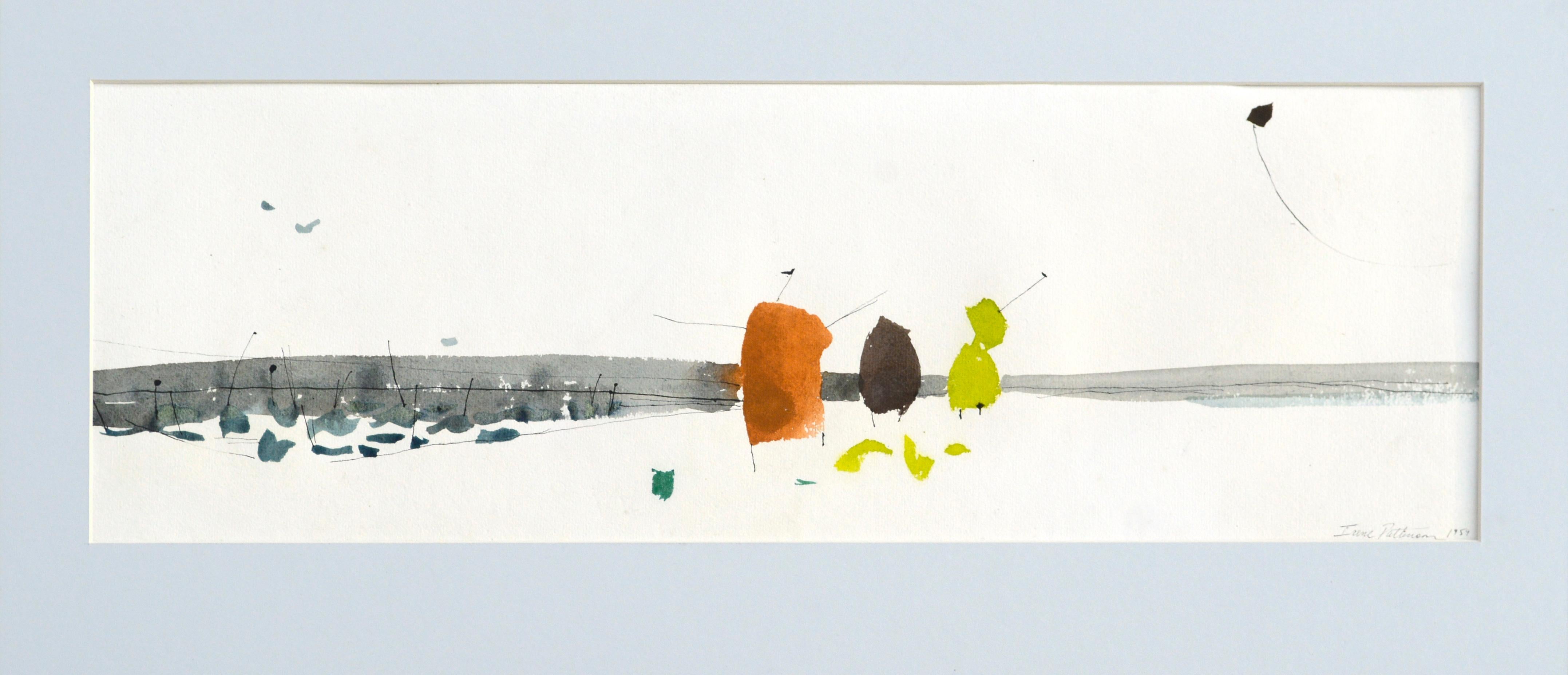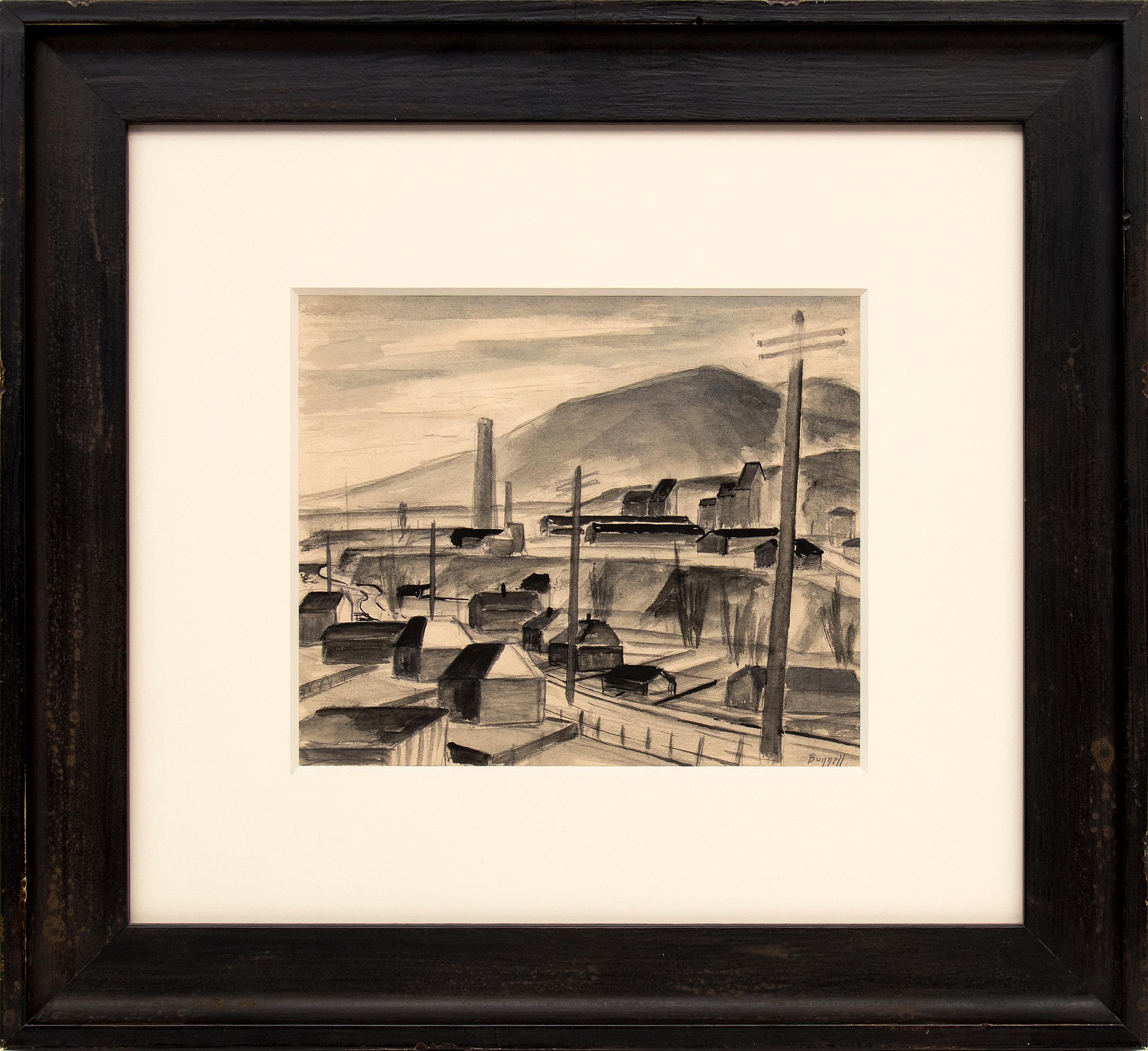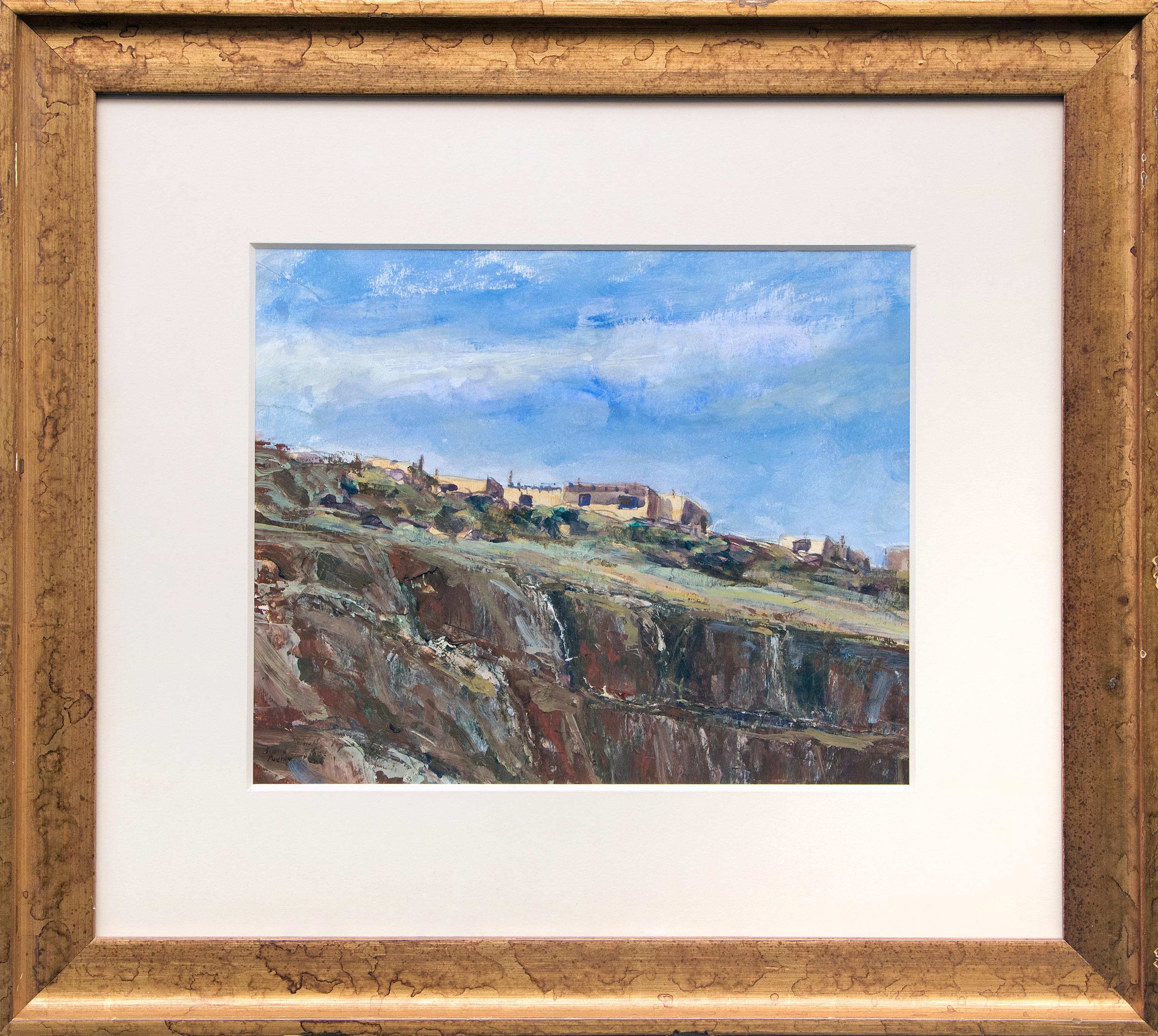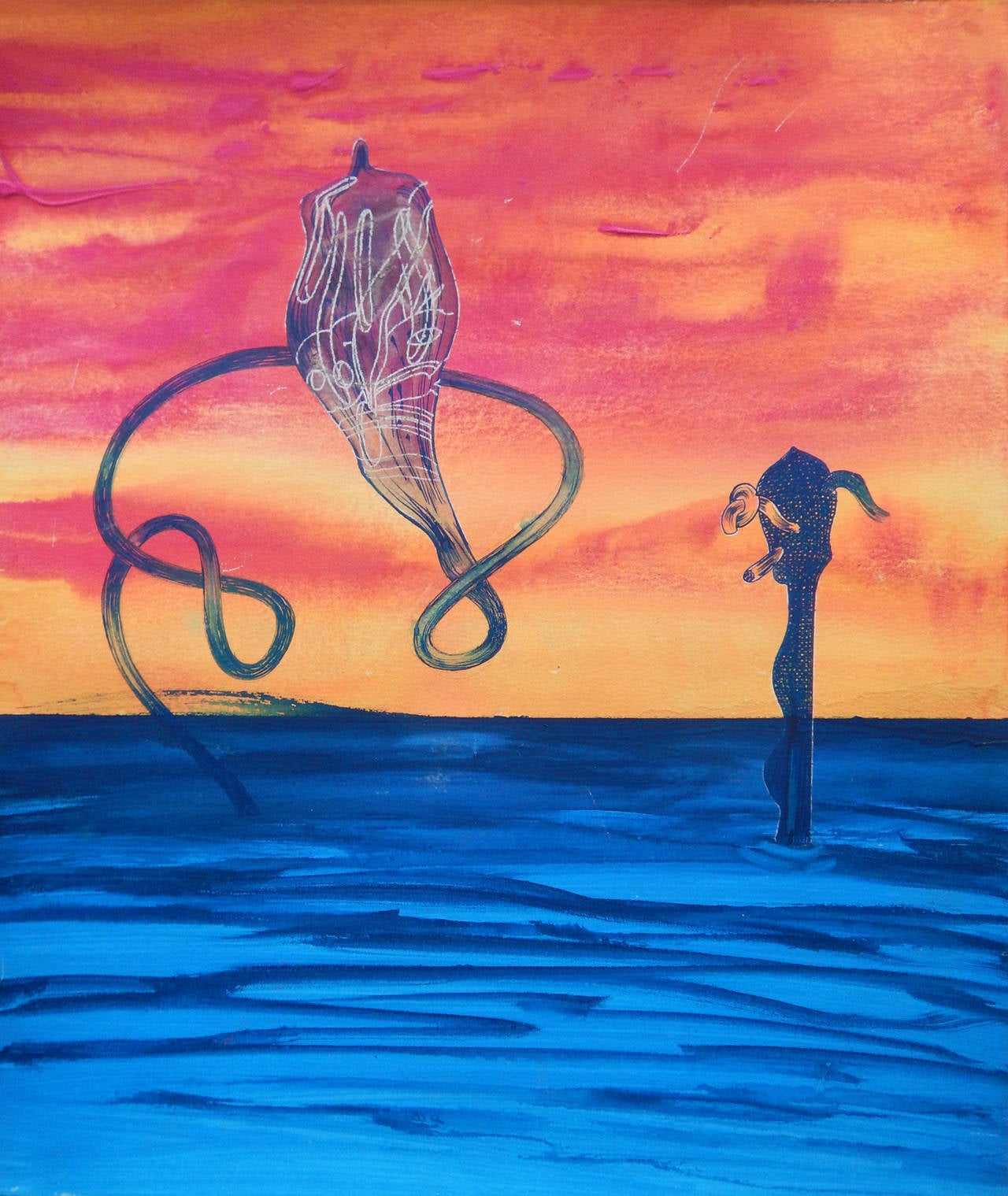Items Similar to Church in Leadville, Colorado, 1930s Framed Landscape Watercolor Ink Painting
Video Loading
Want more images or videos?
Request additional images or videos from the seller
1 of 14
Jenne MagafanChurch in Leadville, Colorado, 1930s Framed Landscape Watercolor Ink Painting 1938
1938
About the Item
Rare WPA era original painting by Colorado/Woodstock modernist, Jenne Magafan (1916-1952). Church in Leadville, 1938 is presented in a custom frame with all archival materials, outer dimensions measure 22 ½ x 28 ¼ x 1 ¼ inches. Image size is 12 ¼ x 19 inches.
Piece is in good vintage condition - please contact us for a complete condition report.
Provenance: Estate of Ethel Magafan
Expedited and international shipping is available - please contact us for a quote.
About the Artist:
Jenne and Ethel Magafan were identical twins, born in Chicago to a Greek immigrant father and a Polish mother. Due to health concerns about their father, the family moved to Colorado, living first in Colorado Springs and then in Denver. He was a proud supporter of their artistic ambitions but died suddenly 1932, a heavy blow to both of them. They attended East High School in Denver, where they found a mentor in their art teacher Helen Perry. She had studied at the Art Institute of Chicago but had later abandoned a career as an artist, making her all the more determined to help the Magafan twins succeed artistically.
While still in high school, the twins impressed artist Frank Mechau, and Helen Perry paid for their lessons with him. He subsequently invited them to apprentice with him at his Redstone studio. In 1936, Jenne won the Carter Memorial Art Scholarship and shared it with her sister so that they both could attend the Broadmoor Art Academy in Colorado Springs. Once they ran out of money, Mechau, now teaching there, hired them as assistants. Through their involvement at the Academy, the twins entered into careers as muralists, working at first with Mechau and then with Peppino Mangravite.
In 1939, Jenne was awarded her first commission for a mural at the Albion, Nebraska Post Office. Eventually she won a total of seven commissions. For the work, she traveled across the country in a station wagon. Her daughter has said of her mother's experience that, "They saved up gas coupons as fuel was rationed and drove cross country on ?retreads'-- refurbished old tires."
Federally sponsored murals could stir up excited responses from local citizens. Jenne's favorite mural was Cowboy Dance at the Anson, Texas post office, but the local newspaper took offense to a whiskey jug painted in the lower corner, citing that "Throughout the history of Anson there has never been an open saloon."
Meeting the artists Doris Lee and Arnold Blanch in Los Angeles, the twins learned of the art colony in Woodstock, New York, and in 1945 they went to visit. That same year, their work was exhibited at the Los Angeles Museum of Art and the National Academy of Design. Marrying her longtime love, Edward Chavez, Jenne moved to Woodstock along with her sister where, for the first time, the sisters didn't live together. Ethel didn't look favorably upon her brother-in-law's dominating personality and this forced their styles to develop more independently.
When Chavez won a Fulbright scholarship, the couple traveled to Italy. During this time, Jenne went to visit her sister in Greece, where Ethel was fulfilling her Fulbright. In 1952, the Magafans and their husbands returned to the States, and less than a week after their return Jenne died in Albany Hospital of a cerebral hemorrhage. ©David Cook Galleries, LLC
Awards: State of Colorado Arts and Humanities Award, 1971; Received the first solo exhibition at the Denver Art Museum; Honored posthumously by Historic Denver as part of the Colorado 100.
Education: Cleveland Schools of Art (B.E.A.); Western Reserve University with Henry Keller; Frank Wilcox, William Joseph Eastman & Albert Olson; also studied in Europe, Africa and Asia.
Commissions: Ceiling in drawing room, commissioned by Mrs. Gerald Hughes, Denver, 1936; History of Costume (five murals), Neusteter's, Denver, 1937; mural room and ranch bar, Albany Hotel, Denver, 1937; WPA mural, Cattle Round-up, US Treasury Department, Eureka, Kansas, 1938; Land Rush, Treasury Department, Sayre, OK, 1940.
Exhibited: International Watercolors, Art Institute of Chicago, 1930-49; Contemporary American Painting, University of Illinois, 1952; Artists West of the Mississippi, Colorado Springs Fine Arts Center, 1965; 73rd Western Ann., Denver Art Museum, 1971; Color Exp. Space Retrospective, 1972.
Works Held: Kirkland Museum of Fine & Decorative Art, Colorado; Colby College Museum of Art, Maine; The John H. Vanderpoel Art Association, Illinois.
- Creator:Jenne Magafan (1916 - 1952, American)
- Creation Year:1938
- Dimensions:Height: 22.5 in (57.15 cm)Width: 28.25 in (71.76 cm)Depth: 1.25 in (3.18 cm)
- Medium:
- Movement & Style:
- Period:
- Condition:very good vintage condition.
- Gallery Location:Denver, CO
- Reference Number:
About the Seller
5.0
Platinum Seller
These expertly vetted sellers are 1stDibs' most experienced sellers and are rated highest by our customers.
Established in 1979
1stDibs seller since 2013
264 sales on 1stDibs
Typical response time: 5 hours
- ShippingRetrieving quote...Ships From: Denver, CO
- Return PolicyA return for this item may be initiated within 7 days of delivery.
More From This SellerView All
- Golden Cycle Mill, Colorado, 1940s WPA Mining Watercolor Landscape, Black WhiteBy Charles Ragland BunnellLocated in Denver, COOriginal 1940s watercolor on paper painting by Charles Ragland Bunnell portraying a semi abstracted view of Golden Cycle Mill in Colorado Springs, Colorado. Painted in shades of black and gray. Presented in a custom black frame, outer dimensions measure 18 x 19 ½ x 1 ⅜ inches. Image sight size is 8 ⅛ x 9 ⅝ inches. Golden Cycle Mining and Reduction Company was a mining company in Colorado City (now Old Colorado City) in El Paso County, Colorado. Piece is clean and in excellent condition - please contact us for a detailed condition report. Expedited and international shipping is available - please contact us for a quote. About the artist: Artist and teacher, Charles (“Charlie”) Bunnell worked in a variety of styles throughout his career because as an artist he believed, “I’ve got to paint a thousand different ways. I don’t paint any one way.” At different times he did representational landscapes while concurrently involved with semi- or completely abstract imagery. He was one of a relatively small number of artists in Colorado successfully incorporating into their work the new trends emanating from New York and Europe after World War II. During his lifetime he generally did not attract a great deal of critical attention from museums, critics and academia. However, he personally experienced a highpoint in his career when Katherine Kuh, curator at the Art Institute of Chicago, personally chose one of his paintings – Why? - for its large exhibition of several hundred examples of abstract and surrealist art held in 1947-48, subsequently including it among the fifty pieces selected for a traveling show to ten other American museums. An only child, Bunnell developed his love of art at a young age through frequent drawing and political cartooning. In high school he was interested in baseball and golf and also was the tennis champion for Westport High School in Kansas City. Following graduation, his father moved the family to Denver, Colorado, in 1916 for a better-paying bookkeeping job, before relocating the following year to Colorado Springs to work for local businessman, Edmond C. van Diest, President of the Western Public Service Company and the Colorado Concrete Company. Bunnell would spend almost all of his adult life in Colorado Springs. In 1918 he enlisted in the United States Army, serving in the 62nd Infantry Regiment through the end of World War I. Returning home with a 10% disability, he joined the Zebulon Pike Post No. 1 of the Disabled American Veterans Association and in 1921 used the benefits from his disability to attend a class in commercial art design conducted under a government program in Colorado Springs. The following year he transferred to the Broadmoor Art Academy (founded in 1919) where he studied with William Potter and in 1923 with Birger Sandzén. Sandzén’s influence is reflected in Bunnell’s untitled Colorado landscape (1925) with a bright blue-rose palette. For several years thereafter Bunnell worked independently until returning to the Broadmoor Art Academy to study in 1927-28 with Ernest Lawson, who previously taught at the Kansas City Art Institute where Bunnell himself later taught in the summers of 1929-1930 and in 1940-41. Lawson, a landscapist and colorist, was known for his early twentieth-century connection with “The Eight” in New York, a group of forward-looking painters including Robert Henri and John Sloan whose subject matter combined a modernist style with urban-based realism. Bunnell, who won first-place awards in Lawson’s landscapes classes at the Academy, was promoted to his assistant instructor for the figure classes in the 1928-29 winter term. Lawson, who painted in what New York critic James Huneker termed a “crushed jewel” technique, enjoyed additional recognition as a member of the Committee on Foreign Exhibits that helped organize the landmark New York Armory Exhibition in 1913 in which Lawson showed and which introduced European avant-garde art to the American public. As noted in his 1964 interview for the Archives of American Art in Washington, DC, Bunnell learned the most about his teacher’s use of color by talking with him about it over Scotch as his assistant instructor. “Believe me,” Bunnell later said, “[Ernie] knew color, one of the few Americans that did.” His association with Lawson resulted in local scenes of Pikes Peak, Eleven Mile Canyon, the Gold Cycle Mine near Colorado City and other similar sites, employing built up pigments that allowed the surfaces of his canvases to shimmer with color and light. (Eleven Mile Canyon was shown in the annual juried show at the Carnegie Institute in Pittsburgh in 1928, an early recognition of his talent outside of Colorado.) At the same time, he animated his scenes of Colorado Springs locales by defining the image shapes with color and line as demonstrated in Contrasts (1929). Included in the Midwestern Artists’ Exhibition in Kansas City in 1929, it earned him the gold medal of the Kansas City Art Institute, auguring his career as a professional artist. In the 1930s Bunnell used the oil, watercolor and lithography media to create a mini-genre of Colorado’s old mining towns and mills, subject matter spurned by many local artists at the time in favor of grand mountain scenery. In contrast to his earlier images, these newer ones – both daytime and nocturnal -- such as Blue Bird Mine essentially are form studies. The conical, square and rectangular shapes of the buildings and other structures are placed in the stark, undulating terrain of the mountains and valleys devoid of any vegetation or human presence. In the mid-1930s he also used the same approach in his monochromatic lithographs titled Evolution, Late Evening, K.C. (Kansas City) and The Mill, continuing it into the next decade with his oil painting, Pikes Peak (1942). During the early 1930s he studied for a time with Boardman Robinson, director of the Broadmoor Art Academy and its successor institution, the Colorado Springs Fine Arts Center from 1930 to 1947. In 1934 Robinson gave him the mural commission under the Public Works of Art Project (PWAP) for West Junior High School in Colorado Springs, his first involvement in one of several New Deal art...Category
1940s American Modern Landscape Paintings
MaterialsPaper, Watercolor
- Acoma Pueblo, New Mexico, 1970s Southwest Landscape Scene Gouache PaintingLocated in Denver, CO"Acoma Pueble (New Mexico) is a gouache on paper painting by Wolfgang Pogzoba (1936-1982) from 1978 of a landscape and an adobe home over a cliff side in the town of Acoma Pueblo, NM. Presented in a custom frame, outer dimensions measure 22 ⅜ x 25 inches. Image size is 12 x 15 inches. The Acoma Pueblo is located approximately 60 miles west of Albuquerque, New Mexico. Painting is clean and in good condition - please contact us for a detailed condition report. Expedited and international shipping is available - please contact us for a quote. About the Artist: Wolfgang Pogzeba...Category
1970s American Modern Landscape Paintings
MaterialsPaper, Gouache
- Artists Sketching, California, 1940s Large Modernist Gouache Landscape PaintingBy Frederick ShaneLocated in Denver, CO"Artists Sketching (California)" is an American Modernist scene of three artists working with mountains in the background. Gouache on paper, signed, titled, and dated by the artist in the lower margin. Housed in a custom frame with all archival materials measuring 25.5 x 37.5 x 1.5 inches; image dimensions measure 20.25 x 29.75 inches. Provenance: Estate of the Artist, Frederick Shane About the artist: Painter and printmaker, Missouri regionalist Frederick E. Shane specialized in genre scenes, landscapes, seascapes and portraits executed in a variety of media: oil, watercolor, mixed media, gouache, tempera and lithography. Fundamentally a realist, his work also contains some abstraction, expressionism and surrealism used in treating his subject matter. In the summers of 1925-26 Shane studied with Randall Davey at the recently-founded Broadmoor Academy in Colorado Springs. The Academy was established in 1919 by Spencer and Julie Penrose, prominent philanthropists and art patrons, who donated their family residence for the creation of a local art institution. In the 1940s and early 1950s Shane maintained his contact with Colorado Springs Fine Arts Center (the successor institution to the Broadmoor Academy in 1936). He participated in a number of its annual Artists West of the Mississippi exhibitions and also became a close friend of Boardman Robinson, the Center’s director, and visiting artist Adolph Dehn...Category
1940s American Modern Landscape Paintings
MaterialsGouache
- City Park, Denver, Colorado, Large Semi Abstract Colorful Oil LandscapeBy Edward MarecakLocated in Denver, COLarge format oil painting on canvas of City Park in Denver, Colorado by 20th century Denver modernist, Edward Marecak. Semi-abstract park scene with various types of trees, figures, ...Category
20th Century American Modern Landscape Paintings
MaterialsOil, Canvas
- Near Watsonville, California, Mid Century Landscape Oil Painting House TreesBy Jon BlanchetteLocated in Denver, COMid 20th Century oil on artist board of a white house near Watsonville, California. 1950s landscape painting with house and trees. Presented in a...Category
Mid-20th Century American Modern Landscape Paintings
MaterialsOil, Board
- Autumn Harvest, Original Semi-Abstract Landscape and Figurative Oil PaintingBy Edward MarecakLocated in Denver, COOriginal framed oil painting on burlap by Edward Marecak (1919-1993) titled "Autumn Harvest" from 1987. Signed and dated by the artist in the lower right corner. Presented in a custom framed, outer dimensions measure 20 x 29 x 1 ⅜ inches. Image size is 19 x 28 inches. Provenance: Estate of the Artist, Edward Marecak Painting is clean and in good condition - please contact us for a detailed condition report. Expedited and international shipping is available - please contact us for a quote. About the artist: Born to immigrant parents from the Carpathian region in Slovakia, Marecak grew up with his family in the farming community of Bennett’s Corners, now part of the town of Brunswick, near Cleveland, Ohio. When he turned twelve, his family moved to a multi-ethnic neighborhood of Poles, Czechs, Slovaks, and Slovenians in Cleveland. His childhood household cherished the customs and Slavic folk tales from the Old Country that later strongly influenced his work as a professional artist. During junior high he painted scenery for puppet shows of “Peter and the Wolf,” awakening his interest in art. In his senior year in high school he did Cézanne-inspired watercolors of Ohio barns at seventy-five cents apiece for the National Youth Administration. They earned him a full scholarship to the Cleveland Institute of Art (1938-1942) where he studied with Henry George Keller whose work was included in the 1913 New York Armory Show. In 1940 Marecak also taught at the Museum School of the Cleveland Institute. Before being drafted into the military in 1942, he briefly attended the Cranbrook Academy of Art near Detroit, one of the nation’s leading graduate schools of art, architecture, and design. A center of innovative work in architecture, art and design with an educational approach built on a mentorship model, it has been home to some of the world’s most renowned designers and artists, including Eero Saarinen, Charles Eames, Daniel Libeskind and Harry Bertoia. Marecak’s studies at Cranbrook with painter Zoltan Sepeshy and sculptor Carl Milles were interrupted by U.S. army service in the Aleutian Islands during World War II. Following his military discharge, Marecak studied on the G.I. Bill at the Colorado Springs Fine Arts Center from 1946 to 1950, having previously met its director, Boardman Robinson, conducting a seminar in mural painting at the Cleveland Institute of Art. Although he did not work with Robinson at the Fine Arts Center, who had become quite ill - retiring in 1947 - he studied Robinson’s specialty of mural painting before leaving to briefly attend the Cranbrook Academy in 1947. That same year he returned to the Fine Arts Center, studying painting with Jean Charlot and Mary Chenoweth, and lithography with Lawrence Barrett with whom he produced some 132 images during 1948-49. At the Fine Arts Center he met his future wife, Donna Fortin, whom he married in 1947. Also a Midwesterner, she had taken night art courses at Hull House in Chicago, later studying at the Art Institute of Chicago with the encouragement of artist Edgar Britton. After World War II she studied with him from 1946 to 1949 at the Fine Arts Center. (He had moved to Colorado Springs to treat his tuberculosis.) Ed Marecak also became good friends with Britton, later collaborating with him on the design of large stained glass windows for a local church. In 1950-51 Marecak returned to the Cleveland Institute of Art to complete his Bachelor of Fine Arts degree. A year later he was invited to conduct a summer class at the University of Colorado in Boulder, confirming his interest in the teaching profession. In 1955 he received his teaching certificate from the University of Denver. Vance Kirkland, the head of its art department, helped him get a teaching job with the Denver Public Schools so that he and his family could remain in the Mile High City. For the next twenty-five years he taught art at Skinner, Grove, East, George Washington and Morey Junior High Schools. Prior to coming to Colorado, Marecak did watercolors resembling those of Winslow Homer, John Singer Sargent and Charles Burchfield. However, once in Colorado Springs he decided to destroy much of his earlier oeuvre, embarking on a totally new direction unlike anything he had previously done. Initially, in the 1940s, he was influenced by surrealist imagery and Paul Klee and in the West by Indian petroglyphs and Kachinas. His first one-person show at the Garrett Gallery in Colorado Springs in 1949 featured paintings and lithographs rendered in the style of Magic Realism and referential abstraction. The pieces, including an oil Witch with Pink Dish...Category
1980s American Modern Landscape Paintings
MaterialsOil
You May Also Like
- Society of Six Street Scene - Figurative AbstractBy Bernard Von EichmanLocated in Soquel, CAStunning New York City urban modernist watercolor titled "Summer Afternoon Stroll" by Society of Six artist Bernard Von Eichman (American, 1899-1990), 1...Category
1930s American Modern Landscape Paintings
MaterialsArchival Paper, Watercolor
- 1950s "Figure in Shadow" Figurative Gouache Painting America ModernistBy Donald StacyLocated in Arp, TXDonald Stacy "Figure in Shadow" c.1950s Gouache paint on paper 24" x 18" unframed Unsigned Came from artist's estate Donald Stacy (1925-2011) New Jersey Studied: Newark School of Fine Art The Art Students League Pratt Graphic Arts Center University of Paris 1953-54 University of Aix-en-Provence 1954-55 Faculty: Art Department of the New School Museum of Modern Art School of Visual Arts Stacy Studio Workshop Exhibitions: Grand Central Moderns George Wittenborn The New School Print Exhibitions, Chicago University of Oklahoma Honolulu Museum Monclair Museum Wisconsin State College Louisiana Art...Category
Mid-20th Century American Modern Figurative Paintings
MaterialsPaper, Gouache
- Mid Century Abstracted Landscape -- Flying A Kite at the BeachBy Irene PattinsonLocated in Soquel, CAPlayful abstracted watercolor of a beach scene by Irene Pattinson (American, 1909-1999). Signed and dated "Irene Pattinson 1959" in the lower right corner. Presented in a new French ...Category
1950s American Modern Landscape Paintings
MaterialsWatercolor, Pen, Paper
- Bather on CoastlineBy Michael Ricardo AndreevLocated in New York, NYBather on Coastline, 2014 Gouache and ink on board 20 x 16 inchesCategory
21st Century and Contemporary Contemporary Landscape Paintings
MaterialsArchival Ink, Archival Paper, Gouache
- Mid Century Modernist Watercolor Landscape with Horse, Cleveland SchoolBy William SommerLocated in Beachwood, OHWilliam Sommer (American, 1867–1949) Spring Beauty Watercolor on paper Signed lower right 12.5 x 17 inches 18 x 22.75 inches, framed William Sommer is seen as a key person in bringi...Category
Mid-20th Century American Modern Figurative Paintings
MaterialsWatercolor
- "The Glorious Flight - Across the Channel with Louis Bleriot" - Children's BookBy Alice and Martin ProvensenLocated in Miami, FLStudy for "The Glorious Flight - Across the Channel with Louis Bleriot"; 1983; Gouache on Illustration Board; 14.5" x 13.75"; Signed Lower Right; Unframed. From Wikipedia, the free encyclopedia Alice Rose[1] Provensen (née Twitchell; August 14, 1918[2] – April 23, 2018[3]) and Martin Provensen...Category
1980s American Modern Figurative Paintings
MaterialsBoard, Gouache
Recently Viewed
View AllMore Ways To Browse
Landscape Asia
Rounded Corner Frame
Vintage Couples In Love
Post Modern 1930s
Round Landscape Painting
Original Western Art Cowboy
Church Cross
West Texas Landscape
Contemporary Maine Landscape Paintings
Twin Landscapes
Vintage Dancer 1930s
Vintage European Landscapes
Italian Vintage Landscapes
1930s Costume
Cowboy Artist Painting
Vintage Colorado
Watercolor Landscapes Colorado
Vintage Style Landscape Paintings

